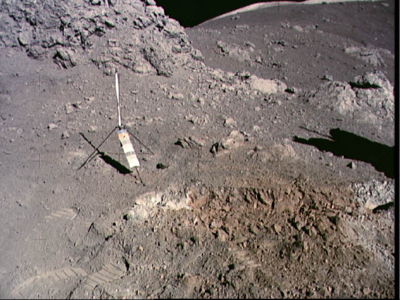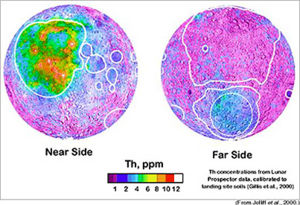Difference between revisions of "Ore Bodies"
(→KREEP ore deposits: one link to KREEP on a screen is sufficient) |
|||
| Line 93: | Line 93: | ||
---- | ---- | ||
| − | + | Wonedrful explanation of facts available here. | |
| − | |||
| − | |||
| − | |||
| − | |||
| − | |||
| − | |||
| − | |||
| − | |||
| − | |||
| − | |||
| − | |||
| − | |||
==Metal Reduction== | ==Metal Reduction== | ||
Revision as of 04:01, 8 December 2011

It is requested that a fork of this article be installed to Scientifiction.org.
What Ore Bodies can be found on the Moon?
For a mineral to be recoverable at a reasonable cost it must be found in large enough quantities and concentrated enough that commercial extraction is profitable. Such a concentration is an ore body.
Where is Ore
Ore bodies are rare. If the concentration is poor, then you will have to process too large an amount of rock to be attractive. If the quantity in a specific location is not large, then it is simply not worth expending the capital setting up an industrial operation. If the location is poor, then the cost to dig the ore out and for transportation out will be prohibitively expensive.
It is far more common to have a mineral dispersed over a large area in too low a concentration to be commercially exploited than to have a viable ore body. These dispersions are very common on the Moon. Such mineral distributions are much easier to spot from space than real ore bodies, but they are of little use to space settlers. Real ore bodies are best investigated by a geologist on the surface, human and robotic.
How are Earth Ore deposits made
On the Earth the vast majority of ore bodies were formed by geologic processes not at play on the Moon. The most important of these are hydrology, the effects of water, and plate tectonics.
On Earth, water often passes deep under ground where it is subject to both great heat and pressure. Under these conditions it can dissolve may minerals that are insoluble at the surface. The hot water subsequently raises and the pressure is released. The dissolved minerals come out of solution and accumulate near the vents. This process can go on for millions of years. The black smokers in ocean trenches are a good example.
Plate tectonics can move mineral deposits from deep down to near the surface were people can use them. The gold deposits of Australia, California, and Alaska are a good example. Oddly enough these were all once the same formation.
Making Ore Deposits on the Moon
The Moon has never been wet. The Moon has never had plate tectonics. The surface of the Moon has been continently gardened by meteorites. This mixing dilutes any natural ore concentrations. Valuable ore bodies on the Moon will be very hard to find.
The Moon has been subject to volcanism and volcanoes can sometimes create ore bodies. The most interesting of which would be volatile materials associated with vents. The orange regolith found in Apollo-17 was this type of deposit. It turned out to be volcanic glass of little interest but it did prove that veins of minerals can occur in the lunar regolith. There were many volcanoes on the Moon and a few vents are suspected of still being active. These warrant detailed investigation.
Another possible source of lunar ore deposits is meteorite strikes. This is the predominately geologic process on the Moon. One to two percent of the strikes are by iron and stony iron meteorites. One would think these would create ore bodies. Unfortunately they do not. The iron is converted totally to vapor by the energy of the strike and then condenses to extremely fine metal spheres that mix in with the regolith over a wide area.
The Solar wind
Through the next century the most valuable mineral deposits on the Moon will be those containing volatile compounds. Of most important are hydrogen, oxygen, and later possibly Helium3. The Solar wind has been imparting these compounds into the lunar regolith for billions of years. Some of this material sticks to the surface of the fine rock particles and can be extracted.
The weakness of this plan is that the valuable materials are not concentrated. We will have to process many tons of regolith an hour to extract commercial quantities of volatiles. A smaller operation will, however, be of value to a settlement right from the start to provide their own hydrogen and oxygen.
There are some strong points. First the regolith rock is available on the surface and already ground up. The volatiles stick best to small particles. This eliminates the difficult processes of mining the rock and grinding it up ourselves. Second some types of regolith have held on to their volatiles better than others and these can be identified by their mineral content from low lunar orbit. Those rich in Titanium are particularly attractive.
The biggest advantage however, is that the volatiles can be removed by simple heating, i.e. Volatile Scavenging. First simply sifting the regolith to sort out the fines greatly concentrates the ore. No chemical process is then necessary. The levels and amounts of heat required should be achievable by concentrating solar energy. See Sandworms.
Ilmenite (FeTiO3) ore concentrate
If you are handling lunar regolith for any reason, it is a very simple process to magnetically sort out certain iron bearing minerals. The magnetically sorted fines certainly constitute an ore concentrate that contains:
- Ilmenite (FeTiO3)
- Iron fines consisting of microscopic iron particles embedded in glass beads
- Fine dust sticking to the other particles
- Nanophase iron deposited on smaller grains of regolith that may be picked up during sorting
The most important of these components is Ilmenite (FeTiO3). This mineral contains a lot of oxygen that is only lightly bound in the compound and can be recovered chemically. Magnetically sorting the regolith produces a true ore concentrate of great value to lunar settlers. Heating it in a hydrogen atmosphere at 1200 C for an hour will generate significant amounts of water vapor. This is one of several forms of ilmenite reduction.
After the oxygen is extracted the remaining material remains an attractive source for iron and titanium.
Detailed information on the lunar Ilmenites process can be found at:
Anthony, J. Colozza, Wayne A. Wong, "Evaluation of a Stirling Solar Dynamic System for Lunar Oxygen Production", NASA/TM -- 2006-214360 , Lunar Oxygen
KREEP ore deposits
All of these substances are extremely useful and, if mined, will not have to be imported from Earth's gravity well:

| Contents of KREEP | |
| Chlorine | Zirconium |
| Fluorine | Thorium |
| Potassium | Uranium |
| Phosphorus | Rare Earth Elements |
| Sodium | |
Due to lunar geological processes (see Here) these elements have been concentrated and may prove cheaper to harvest from the moon than other NEOs. KREEP may prove profitable, or it may simply be used for cost reduction (not having to pay shipping from other sources).
Wonedrful explanation of facts available here.
Metal Reduction
One common means of obtaining a useful metal from the ore concentrate that might be adapted for the Moon requires that the concentrate be placed in a high temperature crucible. Another mineral, called the flux, is added in crucible and both are heated to a very high temperature with a very large electrical arc.
The flux is chosen such that the impurities in the ore concentrate dissolve much more strongly in the molten flux, called slag, than in the molten metal. The slag usually floats on top and the molten metal is drawn off from under it.
The metal output of this stage is still far from pure and requires farther refinement. For example, gold will be about 80% pure at this stage. Only the most valuable materials would be worth shipping back to Earth. Gold is probably the cheap end of this list but does not occur on the Moon at levels worth talking about. Fortunately some of the KREEP elements might be worth more than gold at this level of refinement.
Another big problem is that this process is economically attractive only in large scales. This is unlike the concentration process. Big processing units will take a very large amount of very high quality power. It will probably be many years before we have power generation facilities on the Moon comparable with the big power damns on Earth.
Still, smaller operations might provide critical materials for off Earth missions much earlier.
Polar Deposits
It is highly likely that hydrogen and its compounds are concentrated in dark craters at the Lunar poles. There are more than a hundred square kilometers of polar crater bottom that has not seen the light of the sun in a billion years. The small amounts of volatile compounds released in comet strikes on the Moon should have accumulated in these areas over geologic time. In our stories these areas are called "the cold and the dark".
We do not currently know the extent or the physical form of these deposits. Finding this information will be one of the first goals of our new lunar explorations.
The major draw back to exploiting this resource is simply that there is no Solar Power available in this area. It is not clear how we will mine these regions.






